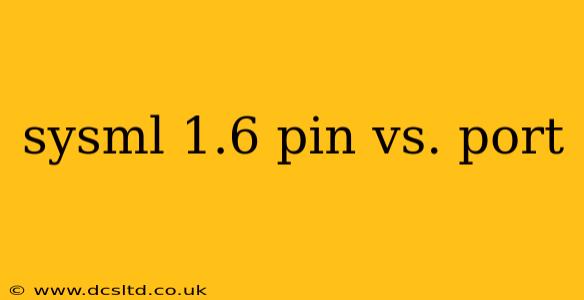System Modeling Language (SysML) is a powerful tool for systems engineering, allowing for the detailed modeling and analysis of complex systems. Within SysML 1.6, the concepts of pins and ports are often sources of confusion. While related, they serve distinct purposes and represent different aspects of system interaction. This article clarifies the differences and helps you understand when to use each.
What are Pins in SysML?
Pins represent individual interaction points within a block's interface. Think of them as individual wires or signals carrying specific data. They're used to define the detailed connections between blocks, showing precisely which signals are exchanged. Pins are primarily used to model the implementation level of interaction, representing the low-level details of signal flow. They are often associated with specific data types and can have properties like direction (in, out, inout) and multiplicity.
Key characteristics of pins:
- Detailed level of interaction: They specify individual signal connections.
- Data-centric: They focus on the data being transmitted.
- Implementation-focused: They represent the low-level details of signal flow.
- Used within interfaces: They are defined within the interface block of a larger system.
What are Ports in SysML?
Ports, on the other hand, represent higher-level interaction points on a block. They represent a collection of interactions, often encapsulating multiple pins or representing a more abstract communication mechanism. Ports are used to model the architectural level of interaction, focusing on the overall communication between blocks without going into the granular details of individual signals. They can be thought of as connectors or interfaces that bundle together multiple pins, or that represent interactions that aren't easily broken down into individual signals.
Key characteristics of ports:
- High-level interaction: They represent a collection of interactions or a general communication mechanism.
- Abstraction: They focus on the overall communication rather than individual signal details.
- Architecture-focused: They represent the high-level communication between blocks.
- Can encapsulate pins: A port can group multiple pins to represent a more cohesive interaction.
Pins vs. Ports: A Practical Analogy
Imagine a computer's USB port. The port itself is a port in the SysML sense – it represents a general interface for connecting devices. However, within that USB port, there are several individual signal lines carrying power, data, and ground. Each of those signal lines would be represented as a pin in a SysML model. The port encapsulates the functionality and connection type, while the pins define the specific signal flow.
When to Use Pins and When to Use Ports?
The choice between pins and ports depends on the level of detail required in your model.
- Use pins when: you need to model the detailed signal flow between blocks, specifying individual data signals and their properties. This is particularly useful when modeling low-level interactions or hardware designs.
- Use ports when: you need a higher-level abstraction of interaction, focusing on the overall communication mechanism without delving into the individual signals. This is useful when modeling architectural designs or high-level interactions between software components.
How Do Pins and Ports Relate?
Ports and pins can work together. A port can be refined or decomposed into pins. This allows for a hierarchical representation of the interface: a high-level view using ports, and a detailed view using pins. This layered approach helps manage the complexity of large systems models.
Are there different types of ports?
Yes, SysML allows for different types of ports to represent various interaction mechanisms, such as:
- Standard Ports: General-purpose ports for any type of interaction.
- Interface Ports: Ports that use a defined interface block, specifying the set of interactions it supports. This helps enforce consistency and improves model maintainability.
By understanding the nuances between pins and ports in SysML 1.6, you can create more accurate, efficient, and manageable system models. Choosing the appropriate element depends on the level of detail needed for your specific modeling needs, whether it is a highly granular low-level design or a more abstract high-level architecture.
